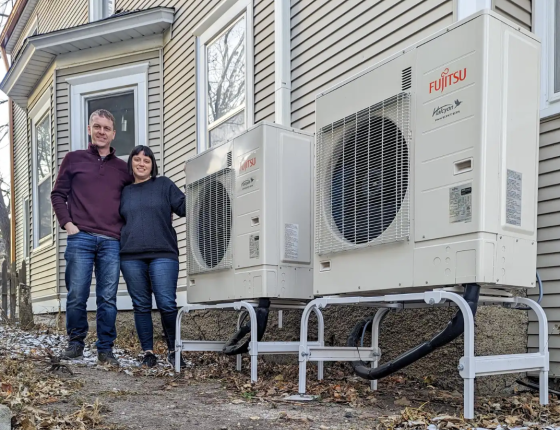When Kristin and William bought their 1909 two-story, single-family home in St. Paul, they knew the house would need extensive updating. The home hadn’t been updated for nearly 50 years, and the couple wanted to improve its energy efficiency and comfort.
As energy professionals, Kristin and William were committed to reducing the home’s carbon footprint while taking advantage of renewable energy resources. With the help of the contractor, Justin Riddle of Paltrin, and the consulting of Center for Energy and Environment (CEE), the couple decided to transition their home to be fully electric.
Determining project priorities with an energy audit
Before Kristin and William started renovations, CEE conducted an energy audit to provide a baseline energy model for the home, as well as projected energy models that showed how different weatherization improvements and heat pumps would affect the home and its energy use.
“We knew that going all electric was possible, but didn't have the expertise to determine HVAC and other systems for the home,” said the homeowners. “We wanted a baseline of energy efficiency so we could understand how effective our upgrades were at project completion. It also helped us to model the system size necessary to heat and cool our renovated home.”
Together, these models were used to help the general contractor, Justin, and the homeowners decide which improvements to make and how to prioritize them. To reach their goals of carbon reduction, energy efficiency, and comfort, they decided to fully electrify the home.
According to Justin, “[CEE’s] breadth of knowledge [was] incredibly valuable when discussing and planning our project. Their insights and recommendations helped us make informed decisions to achieve the best possible outcomes.”
Throughout the project, CEE continued to collaborate with Justin by conducting site assessments and providing technical expertise and recommendations to reach Kristin’s and William’s goals.
Making electrification and weatherization improvements
As they planned the renovation, Kristin and William decided to remodel the entire house, taking it down to the studs so they could make several upgrades at once. While the home was gutted, they made electrical, plumbing, insulation, air sealing, and ductwork improvements that they expect will give the house another 115 years of life.
The couple upgraded their electrical wiring and panel to accommodate an increased electrical load before installing a heat pump water heater and a cold climate air source heat pump (ASHP) with electric resistance backup. They also replaced all their appliances with all-electric Energy Star options.
Beyond equipment and appliance improvements, the home was also weatherized to withstand Minnesota’s extreme temperatures. By air sealing and insulating the attic, walls, and crawlspace and replacing or reconditioning some doors and windows, the homeowners ensured their home would be more energy efficient and comfortable.
In the future, the couple would like to add a charger for their electric vehicle in the garage and install solar panels on the roof to lower electric bills.
A more efficient, comfortable home
Once the renovations were done, the couple had CEE return to complete final testing and compare the initial modeled energy use to the actual energy use post-renovation. Not only did this help them understand the progress they had made, it also helped them qualify their projects for rebates and tax credits.
In the end, the home had a nearly 75% reduction in energy consumption. This dramatic increase in energy efficiency will also lead to more comfortable, consistent temperatures in the home, regardless of outside temperatures.
Whether you’re looking to make your new build energy efficient or you have an extensive remodel or renovation planned and want to make the most of it, CEE’s New Construction team can help. We help architects, builders, developers, and homeowners meet their sustainable building goals through consultation and energy ratings and certifications.
